Legendary: it’s an overused word. But some beers literally are legendary, in the sense that far more people will have heard of them than will ever see them or taste them.
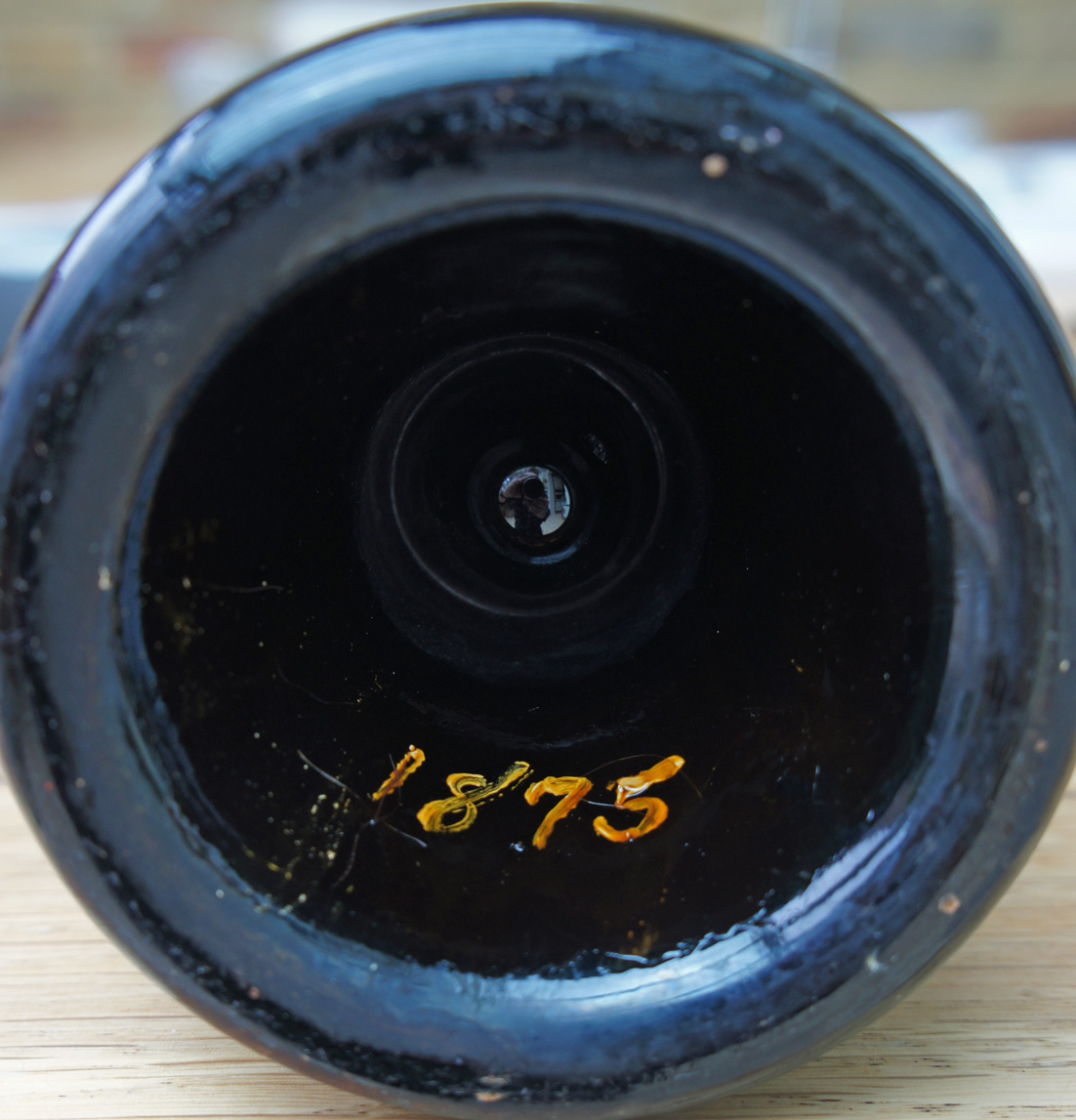
One indisputably legendary beer is Allsopp’s Arctic Ale, the powerful, rich Burton Ale, original gravity 1130, north of 11 per cent alcohol, brewed in Victorian times specifically for expeditions to the Arctic Circle by British explorers. There are a very few bottles left of the Arctic Ale brewed for the expedition under Sir George Nares which set out in 1875 to reach the North Pole. And this week I drank some.
I can’t think of superlatives high enough to describe how thrilled, privileged, lucky, honoured I felt to get this once-in-a-lifetime opportunity to try a beer 137 years old, with so much history behind it. This is exactly the same beer the Victorian journalist Alfred Barnard drank when he visited Allsopp’s brewery in Burton upon Trent in 1890. Subsequently Barnard wrote the experience up in his chapter on Allsopp’s in Noted Breweries of Great Britain. How often do you get to compare someone’s 122-year-old tasting notes with your own experience?
The man to whom I owe this honour is the American home-brewer Chris Bowen, who became, in his own description, “obsessed” with the story of Arctic Ale, when a bottle brewed for the 1852 Arctic expedition headed by Sir Edward Belcher (which was looking for Sir John Franklin’s famously lost expedition of 1845) appeared on eBay. Chris researched the history of Arctic Ale, and eventually organised his own expedition to the Arctic Circle, to brew a modern version of Arctic Ale on the shores of Hudson Bay.
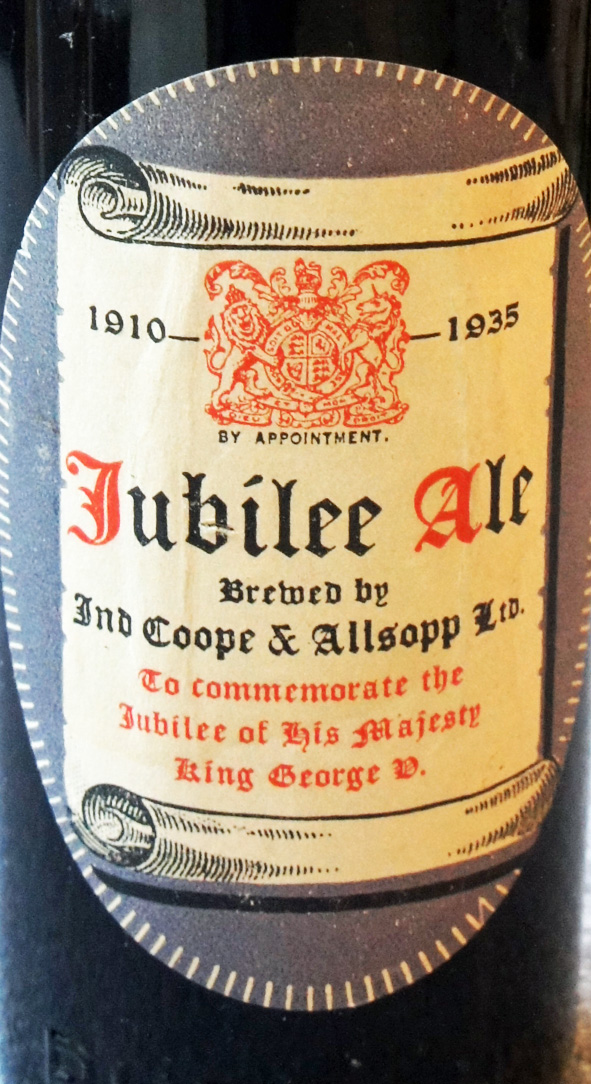 In the past six months, explorers in the cellars of the former Allsopp’s brewery in Burton have uncovered a couple of stashes of old beers that included some three dozen bottles of 1875 Arctic Ales, somehow left over and forgotten. Most of these have gone to the National Brewery Centre in Burton; a few were opened and tasted by lucky Burtonites – and one was brought down to my home in West London by Chris Bowen, who had flown over from the US to give a talk about Arctic Ale at the NBC.
In the past six months, explorers in the cellars of the former Allsopp’s brewery in Burton have uncovered a couple of stashes of old beers that included some three dozen bottles of 1875 Arctic Ales, somehow left over and forgotten. Most of these have gone to the National Brewery Centre in Burton; a few were opened and tasted by lucky Burtonites – and one was brought down to my home in West London by Chris Bowen, who had flown over from the US to give a talk about Arctic Ale at the NBC.
On his way from Burton to West London Chris took a wide detour to pick up Ron Pattinson, who flew from Amsterdam to Stansted to ensure he wouldn’t miss a tasting opportunity almost as rare as transits of Venus. We were joined by John Keeling, brewing director at Fuller, Smith & Turner in Chiswick, who lives not too far from me, and who has just (with the help of Ron) brewed a beer that is a not-too-distant relative of Arctic Ale (albeit half the strength), a 1930s version of Fuller’s Old Burton Extra, for the brewery’s Past Masters series of “revival” beers.
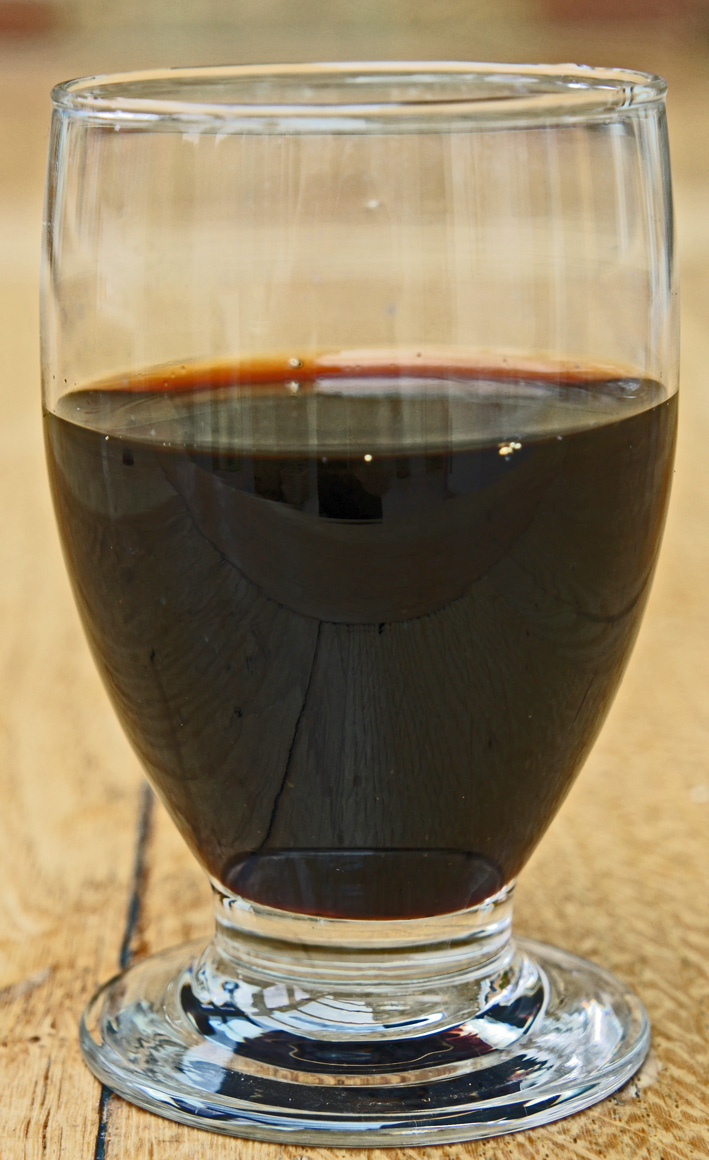
With such a gathering, I felt as host I needed to at least offer some beers to compare with 137-year-old Arctic Ale: fortunately I’ve been sitting on a couple of gems for 20 or so years, and there would never be a better time to open them. Thus we started the session, suitably enough, on Jubilee weekend, with a Jubilee beer: brewed for George V’s silver jubilee 77 years ago, in 1935. The name on the label was Ind Coope & Allsopp – Ind Coope had merged with its Burton neighbour Samuel Allsopp the previous year – but the bottle was embossed “ALLSOPP”, and the beer was very probably a close match to Arctic Ale: Chris Bowen said it reminded him of the 1875 beer, despite being 60 years younger. It was still completely drinkable: fruity, powerful, oily, completely still, dark as the hobs of hell, an underlying sweetness that came through only over time, a beer, as John Keeling said, for sipping slowly, like sherry.
Next up was one of only a couple of other beers that might compare in age and rarity to Arctic Ale, a 1902 Bass King’s Ale that my brother had bought me back in the 1990s. The red wax seal over the cork suggested this was one of the 1929 releases of the 1902 brewing: unfortunately at one point early in its time in my possession a nasty-looking mould appeared to be breaking through the wax, and the state of the label suggested the bottle had not been stored under ideal conditions in the past. However, when we scraped the wax away the cork looked sound, and came out fairly cleanly.
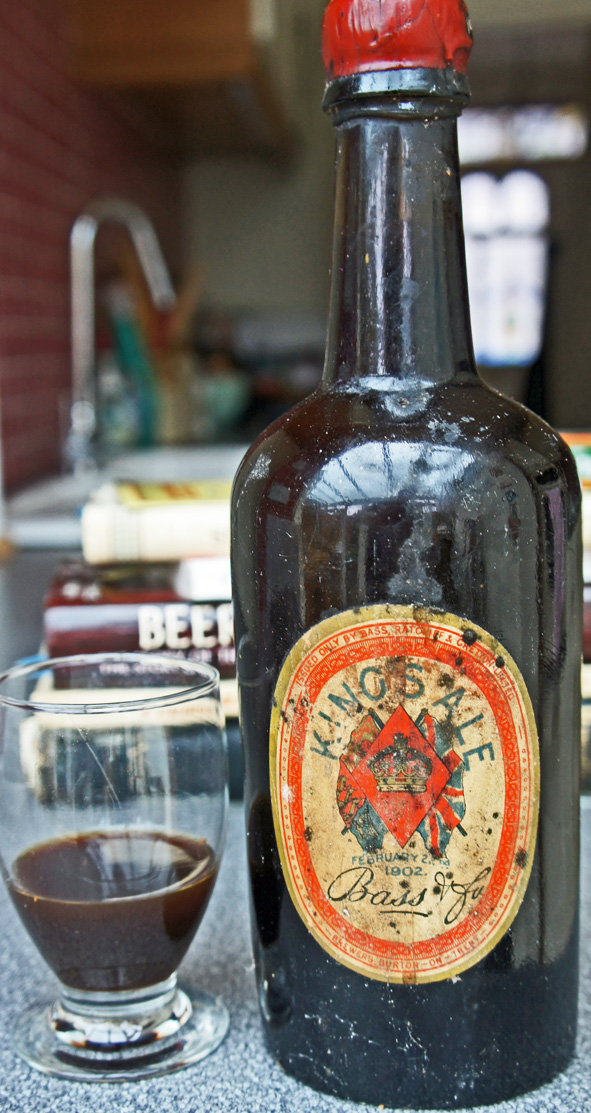
Any fears about the state of the beer under the cork were knocked away by a sniff at the opened bottle, which revealed a beautifully rich fruitcake-like nose. The flavour was tremendous, a beer to trickle across the tongue, with cooked fruit, dark sugar, walnuts and almonds all apparent. Despite being 110 years old, it was perfectly sound, less oily than the 1935 Jubilee Ale, dryer, and a slightly lighter colour. Aged beers like this are often described by commentators in the 19th century as “vinous”, and as John Keeling remarked, if you gave a glass of King’s Ale to someone in a blind tasting and said “grape or grain?”, they would answer “grape” with no hesitation.
The King’s Ale was in a pint bottle: the Arctic Ale Chris had brought down was in the size of bottle known as a “reputed quart”, 26 and two-thirds (Imperial) fluid ounces, one sixth of a gallon. This is the ancestor of today’s standard wine bottle, being within half a spit of 75cl. There was no label left: the only clue to what it was came from the “1875” in yellowed paint that was hidden in the deep punt in the bottle’s base. The cork, alas, fell to pieces as Chris tried to extract it, which led to some bobbing bits and fragments appearing in each glass: but the beer itself, bottled when Benjamin Disraeli was Prime Minister in Britain, when Ulysses S Grant was President of a 37-state United States, when the French Third Republic and the German Empire were each barely four years old, was in excellent condition.
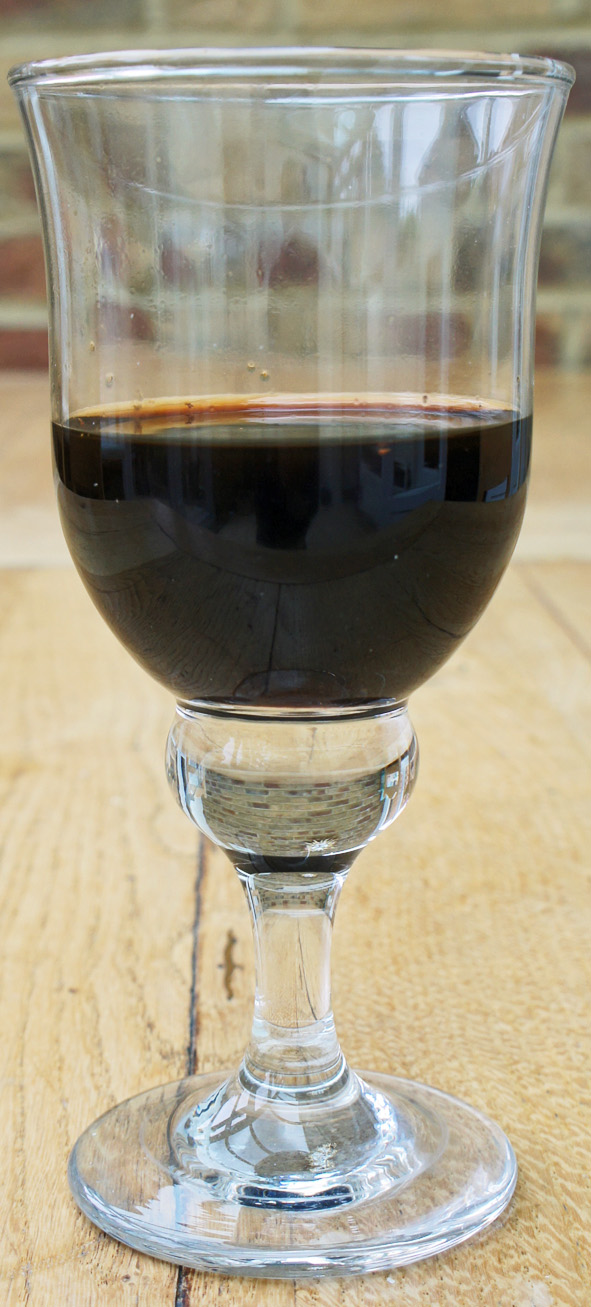
Amazingly, there was still a touch of Burtonian sulphur in the nose, together with a spectrum of flavours that encompassed pears, figs, liquorice, charred raisins, stewed plums, mint, a hint of tobacco, and a memory of cherries. It was dark, powerful and still sweet (unlike the 1869 Ratcliff Ale I was lucky enough to sample seven or eight years ago, which was entirely dry): a thumping Oloroso of a beer: you simply could not have much more than a quarter of a pint without the tongue being overwhelmed. Those frozen sailors on the 1875 British Arctic Expedition, some of whom set a new record for furthest north, travelling to within 460 miles of the North Pole, must have cheered whenever another bottle was thawed out and decanted into their mugs.
Many, many thanks to Chris Bowen, and thanks too to Ron and John for coming over and sharing.


All I can say is wow!
Wow.
Extraordinary! Martyn, just one question. When you tasted these amazing finds, did you ever have a taste memory such as, “oh that is somewhat like that barley from that small brewer from Yorkshire who brewed a one-off for that CAMRA festival some years ago”, or “this is not all that different from that American strong ale I had once in London at the White Horse”?
Or were these horses of a completely different colour?
Gary
I meant barley wine of course.
Ron or anyone else reading who was there, feel free to answer too.
I am curious in other words if these beers or some of them were recognizably beer or are they so different that you can’t relate it to anything of today?
What about hop character too, could you connect any of that to beers of today either in aroma, flavour or astringency/bitterness?
Gary
I was blown away when I found hop character in my 30 year old Tom Hardy’s. Ofourse that was a young fresh session beer in comparison to these.
They were reminiscent of the oldest Thomas Hardy Ales I’ve had, but really not that much like anything else being sold as beer today.
I would love one day to sample Allsopp’s Arctic Ale.
Not a bad drop is it. The Kings Ale is alright too.
Wonderful post – thanks for sharing! I’m very jealous indeed and counting my pennies to save up to buy a bottle myself (probably in vain!)
A word of advice on opening old bottles (I’m a Sommelier as well as beer geek) is to get a device called an “Ah-So” otherwise known as a “Butler’s Friend” Many restaurants that specialise in selling very aged wine, especially port, have one. They have 2 prongs that slide down the side of the cork and grip it for removal. Best to practice first on a bottle of cheap wine though!
Yes, I had been meaning to get hold of one, but failed to do so before the “opening day”. You’re absolutely right, though – essential for dealing with potentially dodgy corks.
Envious doesn’t even come close…
Roger Protz, when tasting a bottle earlier this year of the 1875, mentioned that it was “dark amber”. Photos posted of that tasting confirm that.
At first, I thought this was a chance to confirm that when pale malt ruled the day, indeed the beer would be golden or at least light amber (the 1888 Britannica states that colours of beers ranged from “light amber” to “dark brown”). But it was dark amber and I assume the beer you tasted was too, Martyn.
How to explain this? I think the reason is that, historically, Burton ale was always, or at least was often, dark. Molyneux in his well-known history of Burton and its beer refers to old Burton (not the new pale ale) being “high-coloured” and there is other evidence of this. Thus, I infer that a super-Burton as the Arctic clearly was would hew to older practice and I would guess this continued for the other beers tasted which were made later broadly in the Burton tradition. This may explain too why e.g. Young’s Winter Warmer draught of some years ago, a Burton style I tasted in London, was a similar darkish amber.
Thus, I’d think the general switch-over of mild to a darkish colour around the same time or a little later is a separate development and Burton had its own tradition. How to explain comments in the literature (1800’s again) that strong Burton ale should be as pale as possible? I don’t know. Maybe some writers confused old Burton and new. Or perhaps some Trent Valley producers did fancy a light colour for their strong ale. In the OCB’s entry on Burton, the salutary point is made that the borders of the Burton style, meaning again the pre-pale ale, were never as well-defined as for porter and pale ale and I think that is very true.
Thanks Martyn for the analogy suggested, partial as it is, to very old Thomas Hardy. I’ve had some so it gives me an idea.
By the way I find it extraordinary that no taster, or thus far, has reported acetic flavours. Considering the age I find it amazing.
Gary
I forgot to post the picture of the Arctic Ale in the glass: that’s now been put right, and as you can see, it’s extremely dark, far darker than what I would call “dark amber”, though far from black, and a very similar colour to both the 1935 Jubilee Ale and the King’s Ale. Of course, its colour now undoubtedly is nothing like its colour when brewed, as melaninisation is a constant process in ageing beers.
You’re right about the lack of noticeable acetic flavours: not being a brewing chemist I don’t have an explanation..
Extraordinary! Sampling a beer from when Disraeli was PM. And what it says about the camaraderie of the brewing and beer community is remarkable, although not surprising.
Wow, just wow…
Amazing. History that you can taste.
Maybe we that found it and rescued it should have been asked our permission to open it , it is a major part of our brewing history , We had two tastings in Burton by a select group of Burtonians , The Mayor , brewers and towns National brewery Centre Managers amongst others . All signed a certificate to agree that no other bottles should be opened , or recipe used by any other persons ,sold or auctioned EVER. The bottles are in the care of the NATIONAL BREWERY CENTRE , Burton upon Trent , and will stay in there care in the vaults ,for our future generations of Burtonians as a major part of this Historic Brewing town .
We agreed ,to give Chris permission to anylize and do a brew up in the Arctic with water from the ST JAMES river .as part of his intense interest in the RED HAND story We have been friends with Chris for over 3 years , working on this story . Culminating in Chris doing an event organized by myself and Luke Lucas along with the museum curator , Which i called A Evening With – Chris Bowen – Arctic Ale – The Whole Story . we held this on June 1st 2012 . Where we gave a tasting session , one bottle Chris brewed and an 1875, this to be the final one ever .
The event was widely advertised over several months and open to all .
We take our towns history very seriously as i am sure you appreciate , So should have liked to have been asked for permission .
If you have a problem about the opening of this bottle, then, with respect, your beef is most definitely not with me. I was offered the opportunity to try a historic beer I first wrote about in 2003, and I accepted that offer in good faith.
After speaking with my associates on this matter , we would like to be informed as to who acquired this bottle As no one else should have any , Chris had two , one which he opened to anaylize , the other is in his collection , the others are under lock and key .Only one other person acquired a few illegally and these should all have been returned to the care of the three of us in whos care they will be , in the vaults at NBC THIS PERSON IS KNOWN BY ALL SIGNATURES . legal matters may be enforced by the owner , if it was attained illegally .As it is Burton upon Trent Brewing history . We signed a certificate [12] members in total,and we each hold a copy to say no one can use the recipe, sell, open, or hold tasting sessions after the last time on June 1st . ALL.twelve of us . will be looking forwards to your reply on this matter as we are quite concerned
You could have attended the Event we did with Chris as it was all over websites , and OPEN to ALL. .
“we would like to be informed as to who acquired this bottle”
Re-read the article. I would have though that made it perfectly clear. I am not sure what you are trying to accuse me of, but if you have a problem I suggest you write to me directly – you will find my address on the British Guild of Beer Writers website.
Where did you get this bottle? Who gave it to you to open? I, Luke Lucas, May Arthur and The National Brewery Centre are the ONLY custodians of the found bottles, and NONE are to be opened or sold EVER!! We demand to know where it came from / how you acquired the bottle YOU opened. Your report states – “old beers that included some three dozen bottles of 1875 Arctic Ales” which is totally untrue. The actual bottle count will NOT be disclosed here, and is ONLY known to the above mentioned people. The bottle you opened MAY have been illegally acquired, therefore, we the above mentioned (Not the NBC) are currently seeking legal advice. A lawsuit MAY ensue against the person or persons who had the bottle in there possession that YOU opened. Your prompt reply to this message and the questions we need answering would be a sign of good faith.
Have you actually read the piece? Because if you had, you’d know who brought the bottle down, and that nobody “gave me the bottle to open”.
yes we have all read it , but it is still leaving questions to be answered , why were we not contacted about this tasting taking place ,surely out of sheer politeness .we should have been informed by someone . [1] where this bottle came from and [2]who gave permission to open it , as we and the original owner never had a word from anyone on this . All the bottles we found are under lock and key in vaults ,We have not BLAMED you , we just need answers to the questions asked.. If it was not one of the two Chris had permission to take back to USA , then we need to look into another area as to who acquired this bottle as all those taken illegally, from the building by a certain person , without the owners permission , [myself and Luke Lucas were the only two to have the owners permission to go iinto the vaults and collect the bottles ], those removed illegally, were supposed to have been returned to the care of the custodians .The beer itself is of no monatary value, neither are the bottles [ And by the by, none of the bottles had printed on the bottom 1875 ] It is the recipe that is Burton Towns Brewing History , and will stay here , anyone trying to brew from this may be liable to prosecution by the owner . Chris is the only person given the honour of brewing it outside of uk. No one in uk has that permission .We on the panel have to agree to it and that includes the owner and curator .of the museum amongst. a panel of twelve
So hope this makes it clear to you why we are concerned , as if any more bottles have been taken illegally , then the owner could have a legal right to insist they are returned or to prosecute .
We just need this to be sorted , and soon .
We did not put out this story of a tasting in London , and as its on FB , surley we should have been given the chance to clarify with you , what is allowed, and what is not on Burton Brewing historical matters . Then any confusion could have been sorted out before being printed and put onto FB pages .
Oh my….
I was the one who brought the bottle to this tasting and carry full responsibility for it. These distinguished gentlemen ( whom are some of the world’s foremost experts in beer history), are without any fault or liability here. The bottle was from the original discovery in 2010 and completely recognized by the owner of the 107 Station Street property with full permission to consume(by me) without judgement or further recourse. Had I not have been present at the time of discovery, these bottles and the history would have certainly made their way to the skip. No further bottles exists outside of this example and I am completely disheartened by the lack of regard by which anyone would suggest a potential legal action. I own several examples of this arctic ale as is well documented, and reserve the right to drink them, share them and brew them with whomever I choose.
I understand and respect the history of the brewery and it’s importance to the community of Burton on Trent, CAMRA, and the National Brewery Centre, a tasting like this, and subsequent writings by Martyn, only enhances the story and appreciation to the greater public, and is without harm or injury to anyone.
I am incredulous to the fact that anyone would choose this forum to discuss anything other than excitement and joy by this experience. The remaining bottles are safe and are in your possession so no further discussions or judgements are necessary, the only thing damaged here is my trust and respect for the accusers and accomplices. I am so disappointed that these comments will remain a permanent reminder of an issue that wasn’t, rather than a supportive and positive response.
Thanks Chris , we in no-way had any intention of upsetting you or anyone , but it was such a shock to see it on FB Pages , and we had not been informed about it .
Burtonians defend their History with ferver . We as a panel , had agreed you should have those two bottles , and when we did the official tasting sessions we signed a certificate stating that no more bottles would be opened , sold ect , after the tasting without an agreement being reach by ALL on that panel of signaturies .. June 1st being the last one .. If the guild had said it was YOUR bottle we would not have replied as we did , we only asked the questions , and all it needed was a quick reply . I will tell you what is now to happen to the empty ones , 4 empty bottles will be put on display at NBC and 4 more at the building in Station Street when the owner finds a prominent place for all to see when entering along with the history of this remarkable ale ..We know we owe you a debt of gratitude as you spotted them , as you know we cannot thank you enough .We have been friends for a number of years now and we wish that to be so .
Burton Brewing History is vital to this town and its future generations , rightly so i am sure you will agree .
I hope this explains why we wondered where this bottle came from , all could have been avoided if we had had prior information of what was intended to happen with the beer writers guildmen /women .
Kindest regards, your Buirton Family .
Hear, hear! This hysteria is both hilarious and depressing at the same time. Also, don’t they have spell-checkers in Burton?
My most humble apologies to all involved with this tasting, especially to Chris. We did however have to make sure there were no other bottles taken from those found, other than the ones we all know about. I should have been much more tactful in stead of seeing red so to speak. This Arctic ale is most important the histories of both Burton the U.K and the U.S alike. I guess I am quite overprotective about the remaining bottles. Once again you all have my most humble apologies.
No worries here Luke or May , I should have mentioned this arranged tasting to you both prior to going. I am grateful to be associated with this legendary beer, it’s rich historical value, the oppertunity to have enjoyed tasting it, and to develop a film about it.
Keep up the good work in Burton,
Chris
Hi My dear friend , You know Chris how much we love you and yours , no way would either of us upset you .We were so shocked at it being on FB . I send you and others my PERSONAL APOLOGY , We know just how passionate you are on this Beer , its always good to hear from you and yours .Take care , loving regards Your Burtonian friends x
Excellent article Martyn (though can you write one that doesn’t spark controversy?). Enjoy reading about tastings of such historical beers, and disseminating that information far and wide, since the majority of people think all beer goes bad in a few months (and aging is only for wine).
“Excellent article Martyn (though can you write one that doesn’t spark controversy?”
1) Thank you very much
2) No, don’t believe in it
[…] An 1875 Arctic Ale tasting (Martyn Cornell’s Zythophile) […]
[…] 1875. Here's an excellent read on a tasting I did with some friends in London a few months back: http://zythophile.wordpress.com/2012/06/10/an-1875-arctic-ale-tasting/ __________________ My beer website: […]
I know this is an old post but was wondering about the demands of The National Brewery Centre and how anyone can claim ownership over the recipe or any privately owned bottles. What is the problem? I can’t imagine they’d still be covered by any sort of copyright and I fail to see any need to hide the recipe from the world. A recipe from the mid 1800s can’t be more than pale, amber, brown and black malts and likely completely different than their present day counterparts. Even if it could be cloned, at that size its not going to be something that is ever brewed commercially at a large scale.
I was the one that rescued these bottles with a friend of mine ., they are now locked away in the brewery archives . those that were at the tasting I held in the NBC in Burton would tell you it had the taste of a very rich plum pudding , very fruity with a hint of marmite . a very deep ruby in colour , like a very strong barley wine . and was crystal clear [1875]
the recipe is not to be copied with out our express permission .My friend from AMERICA IS THE ONLY ONE WITH THIS AS HE WAS WITH ME WHEN HE SPOTTED THESE BOTTLES .
.the persons present signed a form to say these would be in the charge of the Archives.
these included the town mayor , councillors and local brewers , plus we CAMRA members .
they are to be kept for future generations in our town ,on the proud history we have on brewing here in Burton upon Trent ..And these brews are part of our heritage. So , sorry but no one will be allowed to use the original recipe.
Dream on, Florence, nobody has copyright in a 138-year-old beer recipe.
Well, having brewed quite a few historical beers, and having a look at a decent number of logs, I’d love to have the recipe, but it would not be too difficult to guess.
I think keeping the recipe secret might be a bit extreme. No one, NO ONE, can repeat a brew from this time 100%; different barely varieties, malting processes, seasonal variances, growing regions, hop cultivars, long gone mixed yeast cultures, inconsistencies with thermometry, etc. all add up exponentially to create a vastly different beer.
I would think just a simple grist bill would not harm the history of Burton. It would give those who are interested in history an example of what the pinnacle of brewing is, thus allowing them to pay homage to such a rich and meaningful history.
It is understandable why people would want the history preserved (and unchanged), but surely you could understand that the people who will brew it, only brew it out of admiration and respect?
If I can see the whole evolution of Barclay Perkins IBSt recipe (with a lot of digging), why not let people share in this beer? A beer far more iconic to many of us beer history nuts.
My great grandmother was “Jessie” Allsopp, who was married to my great grandfather, Harold Halliday of Montreal Canada. Fascinating information. All the best.
[…] Info Source: The undisputably legendary beer Allsopp’s Arctic Ale, the powerful, rich Burton Ale, original gravity 1130, north of 11 percent alcohol, brewed in Victorian times designed for expeditions to the Arctic Circle by British explorers. There are hardly any bottles left of the Arctic Ale brewed for the expedition under Sir George Nares which lay out in 1875 to reach the North Pole. […]